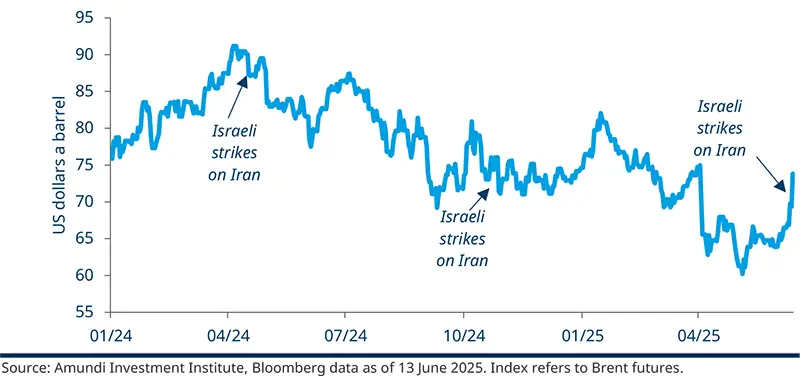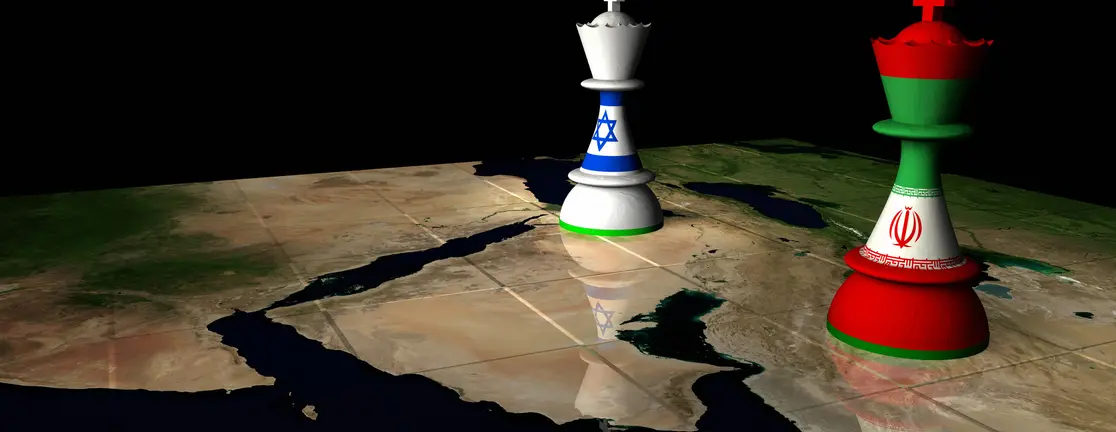Summary
After four days of exchanging attacks, Israel and Iran continued to defy international calls for de-escalation as the conflict between the two regional powers intensified. The situation is evolving, and the risk of escalation remains high. However, we expect the main theatre of conflict to not escalate beyond the region.
The attack pushed oil prices higher last Friday, introducing additional uncertainty and risks to global economic growth while exacerbating inflationary pressures. With the diplomatic route still open and oil infrastructure less likely to be the main target, we maintain our Brent crude oil target at $63 per barrel by the end of 2025 and $68 by the end of 2026, as actual damage to supply capacity appears limited. Although we do not expect a blockade of the Strait of Hormuz, it remains a critical factor to monitor due to its potential impact on oil prices and global supply stability.
As we have emphasised over the past years, geopolitical risks have intensified globally, making it key to analyse possible scenario developments. In the short term, we believe this escalation could trigger some profit-taking after the recent strong performance of risky assets. These developments also reinforce the need to maintain a well-diversified stance with hedges in place and exposure to commodities.
What are the reasons and consequence of Israel’s strike on Iran?
Last Friday, Israel decided to strike Iran’s nuclear capabilities now because Israeli intelligence allegedly revealed that Iran was increasingly close to reaching a ‘point of no return’ in developing a nuclear weapon. While we had warned of the growing risk that Israel may strike Iran’s nuclear capabilities (also due to growing domestic political challenges in Netanyahu’s governing coalition), the timing of the attack is surprising given the ongoing talks with the US for a nuclear deal with Iran.
What are the scenarios moving forward?
The situation is still evolving and the extent of the Israeli operation and Iranian retaliation remains unclear. It has not been confirmed to what capacity Israel has destroyed Iran’s military and nuclear capabilities.
Israel may struggle to destroy Iran’s nuclear capabilities for good without US military support (e.g., bunker buster bombs), but its strikes will be able to ‘set back’ Iran’s nuclear ambitions for some time. If Israel does not permanently destroy Iran’s nuclear capabilities, then Iran still has an interest in talks to maintain the capabilities it still has, implying talks may not be dead.
Based on the current information, we expect the route for diplomacy to remain open (after a retaliation), as the Iranian regime considers its best option to survive is diplomacy. Iran has already expressed the desire for talks.
It is unclear, however, if Israel will allow such diplomacy to go ahead. Israel’s attacks go beyond decimating Iran’s nuclear and missile capabilities and seem to aim at destabilising the regime. Israel’s modus operandi is implying that it seeks to topple the regime by also hitting domestic energy and water infrastructure – by making life more difficult for the domestic population, it increases the risk for public dissatisfaction. Netanyahu has hinted at regime change being a desirable side effect of Israeli strikes on Iran.
This increases the risk that Iran goes for asymmetric escalation by encouraging proxies to get involved or by beginning disruptions in the Strait of Hormuz, but likely only later in the conflict once Iran sees it’s abilities to act increasingly limited.
The US could also still be drawn in over growing concerns that Iran may be ‘rushing for the bomb’ at its most secure nuclear site which Israel will struggle to reach without US intervention.
Scenarios following Israeli attack

What are the implications on oil price?
We do not anticipate a blockade of the Strait of Hormuz.
Following Israel’s attack on Iran’s nuclear sites,Brent crude oil prices spiked to $78 intraday—the largest increase since March 2022—, before settling to around $73 (as of 16 June afternoon). This significant movement reflects growing concerns over Iran's oil production capacity. Currently, Iran produces approximately 4.7 million barrels per day, and the recent spike in oil prices implies a potential reduction of 2 million barrels per day, which is significant and likely an overreaction by the markets.
So far, the impact on oil facilities is limited. Israel strikes on Iran’s energy so far mainly aimed at disrupting domestic consumption. Attacks on Gulf oil infrastructure are mainly likely in case of the conflict widening beyond Israel and Iran. A disruption in the Strait of Hormuz (via a blockade or vessel intimidation) is more likely once Iran runs out of options.
In the short-term, we do not expect a blockade of the Strait of Hormuz. Iran is currently reeling from the attack, with its leadership in disarray, likely lacking the organisational capabilities to block the Strait. Blocking Hormuz would also likely increase Israeli military response and risk drawing in the US, likely affecting Iran’s navy. Blocking the Strait would also hit Iran’s oil revenue which it will now need more than before. It also risks alienating regional powers it may need for diplomacy, like Qatar. However, if the regime runs out of other retaliatory options, measures to disrupt shipping and make use of militias become more likely. Isolated attacks and intimidation against ships in the Strait would affect risk sentiment and hit oil prices.
The Strait of Hormuz is a critical passageway, with around 20 million barrels of oil per day transiting through it, meaning that any potential disruption or closure could have a significant impact on supply, pushing oil prices higher in response to these concerns. In the hypothetical event of a complete halt in transit, Brent crude prices could surge to between $100 and $120 per barrel. However, it is important to differentiate between a temporary blockage of the strait and a permanent loss of extraction capacity. The most likely outcome is a period of heightened volatility with sharp price spikes, followed by a gradual return to market fundamentals over the course of the year.
We maintain our target for Brent at $68 per barrel in 2026, with upside risks in case of further escalation.
We maintain our current target for now, while acknowledging that the geopolitical risk premium is increasing. We could consider revising our targets once there is clearer visibility on any actual damage to supply capacity, which at this stage appears to be minimal. Our outlook on oil has been more constructive compared to the consensus, reflected in price targets, which are set at Brent crude at $63-68 , while WTI is expected to reach $60-65 in 2026.
Volatility is expected to persist, with Brent crude prices that could temporally stay above $70 in the short term and upside risks in case of further escalation. However, should this occur, the US and other OPEC countries could increase production to avoid further inflationary pressure, it would not be unexpected to see prices decline below $70 again by the end of the year.
Oil prices spiked on the aftermath of the attack

How is the market reacting and how should investors navigate this geopolitical escalation?
Commodities exposure in asset allocation serves as an effective hedge, helping to mitigate volatility amid the ongoing geopolitical uncertainties.”
Although the most pronounced market reaction occurred in the oil market last Friday, movements in other areas indicate that investors are closely monitoring the situation and the potential for further escalation. Stock markets declined on Friday while gold reached new highs in a classic risk-off behaviour. Overall, equity market impact remains relatively contained for now, signalling that while risks of moving towards a more negative scenario have increased, the overall base case has not changed for the time being
We reaffirm our view that including commodities exposure in asset allocation serves as an effective hedge, helping to mitigate volatility amid ongoing geopolitical uncertainties. The attack occurred just as global financial markets were rebounding from an April downturn, with the global equity index reaching a record high on Thursday, marking a gain of over 20% since the April low. In the short run it could be used as an excuse or a catalyst by investors for some profit taking after a very strong come-back of risk assets. With rising risks to the downside, we believe it is key to maintain hedges in place.







